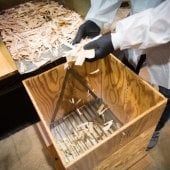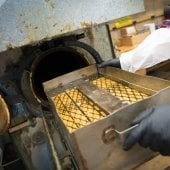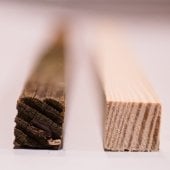WPG Home | Lab Testing | Field Testing | Field Sites | Pilot Plant | Members | Wood Science Links
Our Pilot Plant is where much of the hands-on experimental work is conducted. Facilities include composite panel blending and pressing equipment, a pressure treating cylinder, conditioning rooms, universal testing machines, ovens, an environmental chamber, machining equipment and tools.

Wood Composite Panel Manufacture
Strand board is manufactured using wood species, press settings and additive amounts typically used by large industrial plants to make oriented strand board (OSB). Experimental wood preservatives, or other desired additives may be integrated into the product.

Wood Pressure Treatment
AWPA Standard, E7. Standard Method Of Evaluating Wood Preservatives By Field Tests With Stakes.
When testing a wood preservative system a standardized wood treating procedure must
be followed to ensure the desired preservative levels are retained in the wood. Wood
stake specimens are cut to the required size from clear southern pine sapwood containing
6-10 growth rings per inch. They are then sorted by weight to ensure similar densities
between treatment groups. The wood stakes are pressure treated in separate vats for
each retention level, with the solution concentration calculated to achieve the desired
level of the preservative active ingredient in the wood. This concentration is based
on the gross retention, determined by first treating a test batch of stakes with plain
water, or treating solvent.
To pressure treat a batch of wood stakes, the stakes are first laid in a treating
pan up to three layers high. A space is maintained around all stakes to ensure full
exposure to the treating solution. The stakes are weighed down to prevent floating
and enough treating solution is poured into the pan to ensure the stakes are fully
covered throughout the pressure treating cycle. The treating pan containing the wood
stakes in treating solution is slid into the pressure cylinder and the door is tightly
closed. A vacuum is pulled inside the treating cylinder for the required time to draw
air from the wood voids, replacing the air with treating solution. Compressed air
is then pumped into the cylinder and maintained for the required time to force the
treating liquid to fully saturate the wood stakes. Following the pressure cycle the
stakes remain in solution for a short time to allow for "spring back", and are then
removed to allow the free liquid to drain from the wood surfaces. The stakes are weighed
to determine the retention of treating solution and allowed to air dry. If a preservative
fixation period is required then stakes may be wrapped in plastic to prevent drying
for a given time period before being allowed to dry. Each of the treated stakes will
be cut into two field stakes plus a center, analytical specimen.

Quality Assurance
Quality assurance testing verifies the integrity of each blend and ensures that the panel properties are consistent over time. This is important considering that different "batches" of raw materials, including wood strands, resin and wax will be used as the older material is used and fresh, new material comes in. Quality assurance includes both closely monitoring the deviation from target for each blend component added as well as conducting physical and mechanical tests on the pressed panels. Since the blend requirements of individual research projects may vary, a standard quality control blend is manufactured along with the protocol-specific blends for each new project. The quality control blend remains consistent with regard to type and percent raw materials and additives in order to provide a baseline for test property comparisons. The results of physical and mechanical tests performed on the quality control blend provide reassurance that blending and pressing parameters are within the "normal" range. Quality control charts are maintained for each test type to help define the "normal" range and highlight potential problems, or trends that may be developing.